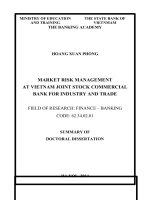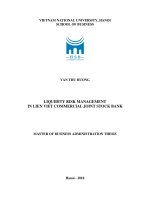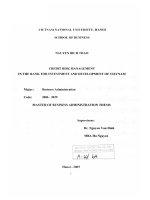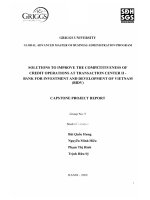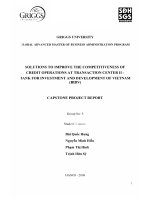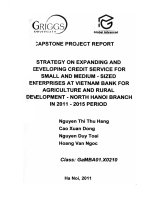LIQUIDITY RISK MANAGEMENT UNDER BASEL ACCORD AT JSC, BANK FOR INVESTMENT AND DEVELOPMENT OF VIETNAM
Bạn đang xem bản rút gọn của tài liệu. Xem và tải ngay bản đầy đủ của tài liệu tại đây (1.11 MB, 110 trang )
MINISTRY OF EDUCATION AND TRAINING
FOREIGN TRADE UNIVERSITY
DISSERTATION
LIQUIDITY RISK MANAGEMENT UNDER BASEL ACCORD
AT JSC, BANK FOR INVESTMENT AND DEVELOPMENT OF
VIETNAM
Major: Master of International Trade Policy and Law
CAO THI VAN ANH
Ha Noi – 2017
MINISTRY OF EDUCATION AND TRAINING
FOREIGN TRADE UNIVERSITY
DISSERTATION
Liquidity risk management under Basel Accord at JSC,
Bank for Investment and Development of Viet Nam
Major: Master of International Trade Policy and Law
Full Name: CAO THI VAN ANH
SUPERVISOR: PhD. NGUYEN THI HIEN
Ha Noi - 2017
ACKNOWLEDGEMENT
Firstly, I would like to express my sincere gratitude to my supervisor PhD. Nguyen Thi
Hien for her support to my study, for her patience, encouragement and immense
knowledge. Her guidance helped me in all the time of research and writing of this
thesis. I could not have imagined having a better advisor and mentor for my study.
Besides my supervisor, I would also like to show my gratitude to all of professors and
lecturers during the master course of International Trade Policy and Law for sharing
expertise, valuable guidance and encourage extended to me.
Last but not the least; I would like to thank my all family members for supporting me
spiritually throughout writing this thesis and my life in general.
Hanoi, December, 2016
1
DECLARATION OF OWNERSHIP
I confirm that I have read and understood the guidelines on plagiarism, that I
understand the meaning of plagiarism and that I may be penalized for submitting work
that has been plagiarized.
If I have been asked to submit hard copy, I understand that the work can’t be assessed
unless both hard copy and electronic versions of the work are handed in.
I declare that all material presented in the accompanying work is entirely my own work
except where explicitly and individually indicated and that all sources used in its
preparation and all quotations are clearly cited.
Cao Thi Van Anh
2
LIST OF ABBREVIATIONS
Acronym
Definition
APEC
Asia-Pacific Economic Cooperation
ALCO
Asset Liability Committee
ALM
Asset Liability Management
APEC
Asia-Pacific Economic Cooperation
BIDV
Joint Stock Commercial Bank for Investment and Development of Vietnam
BSC
BIDV Security Company
BIS
Bank for International Settlements
BTA
Bilateral Trade Agreement
BOD
Board of Director
CBs
Commercial Banks
CAR
Capital Adequacy Ratio
ECB
European Central Bank
FED
Federal Reverse
FPT
Fund Transfer Pricing
GDP
Gross Domestic Product
M&A
Mergers And Acquisitions
LDR
Loan to Deposit Ratio
PBOC
QE
People’s Bank of China
Quantitative Easing
3
Acronym
Definition
ROA
Return on Assets
ROE
Return on Equity
NPL
Net position Liquidity
NSFR
Net Stable Funding Ratio
LCR
Liquidity Coverage Ratio
SBV
State Bank of Vietnam
SDR
Special Drawing Right
TPP
Trans-Pacific Partnership
UN
United Nation
WTO
World Trade Organization
4
TABLE OF CONTENTS
INTRODUCTION ......................................................................................................... 1
1. Rationale ..................................................................................................................... 1
2. Literature Review....................................................................................................... 2
3. Research Objectives ................................................................................................... 3
4. Research Methodology .............................................................................................. 4
5. Structural thesis ......................................................................................................... 4
CHAPTER I: THEORETICAL FRAMEWORK ON LIQUIDITY RISK
MANAGEMENT ACCORDING TO BASEL II ACCORD ..................................... 5
1.1. Fundamental of liquidity risk management ..................................................... 5
1.1.1. The concept of liquidity and liquidity risk ....................................................... 5
1.1.1.1 Definition.............................................................................................................. 5
1.1.1.2 Causes of liquidity risk ......................................................................................... 6
1.1.1.3. Measuring liquidity risk ...................................................................................... 9
1.1.2 Liquidity risk management ............................................................................ 10
1.1.2.1 Definition............................................................................................................10
1.1.2.2 Process of liquidity risk management ................................................................10
1.1.2.3 The roles of liquidity management .....................................................................16
1.2. Liquidity risk management under Basel II Accord........................................ 17
1.2.1. Introduction to Basel II Accord .................................................................... 17
1.2.1.2. The basic contents of Basel II .......................................................................... 19
1.2.2. Liquidity risk management under Basel II Accord ..............................................21
1.2.2.1 Identify liquidity risk management .................................................................... 21
1.2.2.2 Measurement of liquidity risk ........................................................................... 24
1.2.2.3 Controlling liquidity risk management ............................................................. 29
1.2.2.4 Monitoring liquidity risk management .............................................................. 33
1.3 Factor effecting to the liquidity risk management ............................................. 33
5
1.3.1 Legal framework ................................................................................................. 33
1.3.2 Information Technology ..................................................................................... 35
1.3.3 Human resources ................................................................................................ 36
1.3.4 Others ................................................................................................................... 37
CHAPTER II: LIQUIDITY RISK MANAGEMENT PERFORMANCE UNDER
BASEL II ACCORD AT BANK FOR INVESTMENT AND DEVELOPMENT
OF VIETNAM ............................................................................................................. 38
2.1. Introduction of Joint Stock Commercial Bank for Investment and
Development of Vietnam ...................................................................................... 38
2.1.1 General Information about BIDV .......................................................................38
2.1.2. Operational performance of Joint Stock Commercial Bank for Investment and
Development of Vietnam in the period 2010 - 2015 ......................................................39
2.2 Liquidity risk management under Basel II Accord at Joint Stock Commercial
Bank for Investment and Development of Vietnam .................................................42
2.2.1 Legal framework on liquidity risk management at BIDV ............................... 42
2.2.1.1 Legal principles in liquidity risk management at BIDV ....................................42
2.2.1.2 Organization structure for liquidity risk management at BIDV ........................44
2.2.2. Liquidity risk management under Basel II Accord at BIDV .......................... 46
2.2.2.2 Strategic Business Plan ......................................................................................49
2.2.2.3. The policy of liquidity risk management ...........................................................50
2.3 Implementation processes of liquidity risk management under Basel II in
BIDV ..................................................................................................................... 52
2.3.1. Risk identification .............................................................................................. 52
2.3.2 Measuring risk..................................................................................................... 53
2.3.3. Controlling risk ............................................................................................ 57
2.3.4. Monitoring and risk warning ........................................................................ 59
2.4. Overall assessment on liquidity risk management at Bank for Investment and
Development of Vietnam ...................................................................................... 61
6
2.4.1. Achievements ............................................................................................... 61
2.4.2. Shortcomings ............................................................................................... 63
2.4.3. Reasons ........................................................................................................ 65
2.4.3.1 Objective reasons .............................................................................................. 65
2.4.3.2 Subjective reasons ............................................................................................. 66
CHAPTER III: SOLUTIONS FOR PROMOTING ACTIVITIES LIQUIDITY
RISK MANAGEMENT UNDER BASEL II ACCORD AT JSC, BANK FOR
INVESTMENT AND DEVELOPMENT OF VIETNAM ....................................... 69
3.1. Overview of liquidity risk management at BIDV ........................................... 69
3.1.1. Business orientation ..................................................................................... 69
3.1.1.1. Forecast world economy and Vietnam's economy period 2017-2020 ............. 69
3.1.1.2. Business strategy period 2016 - 2020 .............................................................. 72
3.1.2. Oriented development strategy: ..........................................................................74
3.1.3. Objectives towards the Environment and Social Community: ..........................76
3.1.4. Strategic orientation of liquidity risk management ........................................ 77
3.1.4.1. General orientation on the work of risk management ..................................... 77
3.1.4.2. Strategy for liquidity risk management ............................................................ 78
3.2. Solutions to boost the liquidity risk management under Basel II Accord at the
Joint Stock Commercial Bank for Investment and Development of Vietnam ...... 79
3.2.1. Improving the effectiveness of macroeconomic forecasting ........................... 79
3.2.2. Continue to improve policies, regulations, procedures and measuring
instruments liquidity risk under Basel II Accord and vision Basel III..................... 80
3.2.3. Perfecting the system of liquidity risk reports ................................................ 82
3.2.3.1. Liquidity gap report behaviour ........................................................................ 82
3.2.3.2. Report endurance test in the conditions of liquidity crisis .............................. 83
3.2.3.3. Integrated reporting system of early warning indicators ................................ 84
3.2.4. Check the accuracy of the tool, the model used in the management of liquidity
7
risk ........................................................................................................................ 86
3.2.5. Construction Data Warehouse System .......................................................... 87
3.2.6. Improving the quality of workforce risk management ..................................... 88
3.2.7. Initiative in coordination balance sheet according to the principles of Basel II
.............................................................................................................................. 90
3.2.7.1. Develop retail banking services in order to attract funding sources for low-cost
...................................................................................................................................... 88
3.2.7.2. Improve the capital performance ..................................................................... 91
3.2.7.3. Closely manage the level of customer focus to mobilize large balances and
high credit balance ........................................................................................................ 92
CONCLUSION ............................................................................................................ 95
REFERENCES ............................................................................................................ 97
8
LIST OF TABLES AND FIGURES
Table 1: Credit rating of BIDV ..................................................................................... 39
Table 2.1: Bidv fund mobilization ................................................................................. 54
Table 2.2: Bidv Outstanding Loans ............................................................................. 55
Table 2.3: Key target of BIDV for period 2016-2020 ....................................................74
Figure 2.1 Total Assets BIDV ....................................................................................... 40
Figure 2.2 Pre-tax Profit BIDV ..................................................................................... 41
Figure 2.3 ROE BIDV................................................................................................... 41
Figure 2.4 ROA BIDV ................................................................................................. 42
Figure 2.5 Total Deposit BIDV ..................................................................................... 42
Figure 3.1 GDP of Vietnam from 2010 to September 2016 .......................................... 71
Figure 3.2 Foreign exchange USD/VND 2012-2016 (source: Reuteurs) ..................... 72
9
INTRODUCTION
1. Rationale
In recent years, the world economy in general and Vietnam's economy in
particular has undergone many changes since the global financial crisis in 2008, the
crisis began from the United States and spread to many countries around the world led
to the financial collapse, economic recession, declining growth in many economic
sectors which are most severely affected the banking sector with the shedding batch
burst banks in the world. Basel Committee on Banking Supervision pointed out that
one of the root causes of the crisis as liquidity issues have largely been ignored in the
past, the crisis showed that banks dependent on short-term money market funding for
their activities tend to be very large liquidity risk. Vietnam banking sector also
revealed many weaknesses in this period with the aftermath of 9 banks are classified as
weaknesses should be included restructuring BIDV must also participate support,
restructuring of some banks may operate on a small scale and inefficient activities such
as Mekong Housing Bank, Petrolimex Bank, Ocean Bank, Dong A Bank, and
Construction Bank. One of the main reasons for the collapse of the banks located in the
issue of liquidity risk management, the subject of much interest from financial
institutions, commercial banks and central banks around world. With a financial
market like Vietnam infancy, required capacity liquidity risk management is required.
Joint Stock Commercial Bank for Investment and Development of Vietnam
(BIDV) is one of the leading banks in Vietnam, head of the banking sector relative
shares trade on profit before tax and operating indicators, proactive application of
science and technology to modernize the bank in order to meet regulatory requirements
and business value. During its operations, the Bank has always identified risk
management as one of the leading strategic goals, implement governance activities of
the Bank in compliance with international practice; serious implementation the
1
direction of the Government, State Bank contributes effectively implement economic
development plans, the implementation of social and national monetary policy.
Date 03/17/2014, BIDV was selected State Bank implemented the Basel II capital
Treaty under the scheme "Restructuring the system of credit institutions", the
implementation of Basel II, the Bank has had 9 outside banks other goods.
Implementing Basel II assessment will generate significant step for the Bank in risk
management and financial capacity building implementation goal of becoming the
leading bank in Vietnam and regional risk management system standard international
practice, won the appreciation of the strategic shareholders and investors at home and
abroad. The fact that Basel II implementation still faces many difficulties and
challenges in terms of resources, institutions, mechanisms and policies as well as
economic potential but BIDV also expressed determination to implement and mapped
out plans as well as concrete steps to meet the requirements of Basel II.
Starting from the importance of the work of the liquidity risk management
requirements and improve governance at the Bank for the period 2015 - 2020,
cooperation author has chosen the theme "Management of liquidity risk under Basel II
Accord at the Joint Stock Commercial Bank for Investment and Development of
Vietnam" to do research for his master's thesis. The main purpose of this research is
based on analysis and assessment of the situation of liquidity risk management at
Commercial Bank for Investment and Development of Vietnam to propose new
solutions in order to improve governance liquidity risk under Basel II, at the same time
improve the efficiency of business operations of joint Stock Commercial Bank for
Investment and Development of Vietnam, under the strategic direction of the Bank's
Board of directors during the period from 2015 - 2020.
2. Literature Review
In recent years in Vietnam, a number of master's thesis research also had Basel II
and the state applied to risk management in commercial banks. These include master's
thesis: "International Standards for Risk Management in the business of commercial
2
banks as per Basel II and the application in Vietnam" by Nguyen Anh Tuan (2006),
"application of the Basel II accord on risk management systems at commercial banks in
Vietnam" by Chu Thi Huong Giang (2014), the author went deep analysis of the three
pillars of Basel II and associated us to experience Basel II applications in countries
around the world and lessons from the US financial crisis in 2008. the author also
studied the application of Basel II Treaty in risk management in commercial banks
Vietnam trade, thereby offering solutions to improve the application of Basel II risk
management in commercial banks in Vietnam.
However, the above-mentioned projects are mainly research and application of
the Basel II accord on risk management in general without going into a more detailed
analysis of its own liquidity risk management. Also, the work does not have a specific
analysis of the content of the liquidity risk management such as risk appetite, risk
management strategy, governance structure and processes to implement risk
management practice liquidity risk under Basel II at the commercial banks in Vietnam
in general and in commercial banks Investment and Development of Vietnam in
particular.
3. Research Objectives
The purpose of the research study: baseline study activities of liquidity risk
management under Basel II Accord in the Joint Stock Commercial Bank for
Investment and Development of Vietnam, which proposed a number of solutions active
measures to boost liquidity risk management, governance framework liquidity risk
under Basel II.
To achieve the purpose of the study performed the thesis the following tasks:
- Identifying the current liquidity risk, liquidity risk management under Basel II
Accord.
- Application liquidity risk management at Commercial Bank for Investment and
Development of Vietnam toward Basel II Accord.
3
- Propose some solutions to enhance the application of the Basel II accord
operational liquidity risk management at the Joint Stock Commercial Bank for
Investment and Development of Vietnam.
Object of research: The theme focused on liquidity, liquidity risk, Basel II Accord
and the work of liquidity risk management under Basel II at the Bank Commercial
Joint Stock Investment and Development of Vietnam.
Scope of the study: Limit around the regulations and standards of liquidity risk
management mentioned in Basel II, using operational risk management the liquidity
risk management at Commercial Bank investment and Development of Vietnam.
4. Research Methodology
Use Thesis synthetic methods, information analysis, and statistical analysis,
comparative methods. Data collection from primary data (in depth interview) and
secondary data sources are collected mainly from industry reports and the annual report
of the central bank, the Bank and some commercial banks by the students to synthesize
and analyze the matching range of themes. In addition, the sources of data from
sources specialized magazines such prestigious financial magazine, Journal of
Banking, Journal of the money markets, from internet banking website.
5. Structural thesis
Besides the introduction, conclusion, list of tables, references ... the main content
of the thesis consists of three chapters structured as follows:
- Chapter 1: Theoretical framework on liquidity risk management according to
Basel II Accord.
- Chapter 2: Liquidity risk management performance under Basel II Accord in the
Joint Stock Commercial Bank for Investment and Development of Vietnam
Chapter 3: Solutions to intensification of liquidity risk management under Basel
II Treaty in Joint Stock Commercial Bank for Investment and Development of
Vietnam.
4
CHAPTER I: THEORETICAL FRAMEWORK ON LIQUIDITY RISK
MANAGEMENT ACCORDING TO BASEL II ACCORD
1.1. Fundamental of liquidity risk management
1.1.1. The concept of liquidity and liquidity risk
1.1.1.1 Definition
Liquidity in view of the bank, “Liquidity is the ability to meet all financial bank
obligations on time incurred in the course of transactions such as payment of deposits,
loans, payment and other financial transactions operations” (Nguyen Van Tien, 2015,
p. 419)
A bank is considered to have good liquidity if the bank can access to a source of
immediate liquidity fund at a reasonable cost and able to meet all financial bank
obligations
Liquidity risk, is the situation the bank is not able to make the financial
commitments agreed upon with the client when the bank does not raise sufficient
capital and /or asset cannot be sold for a reasonable cost and / or to mobilize capital at
high cost to meet its payment obligations to customers
Similar to the concept of risk has a lot of different perspectives on liquidity risk.
- Liquidity risk is the risk of inability to mobilize liquidity, or if liquidity mobilize with
high fees. Liquidity risk arises from the balance sheet when there is imbalance in the
size and maturity of assets and liabilities.
- Liquidity risk is the risk of loss arising from state status shortage of cash or cash
equivalent assets, particularly the risk of losses arising from the state lacks the ability
to mobilize capital at a reasonable cost, or the inability to sell a property at reasonable
price, in order to make payment obligations.
Circular No. 36/2014 / TT-NHNN (2014) definition of liquidity risk is the risk
due to: (i) credit institutions and branches of foreign banks cannot afford to implement
the obligations in the point incurred financial obligations; or (ii) credit institutions and
5
branches of foreign banks have the ability to perform the obligation when due, but
suffered major losses to carry out that obligation.
At the Bank, liquidity risk is the situation the Bank has no liquidity to clients as
committed or to mobilize capital at high cost to meet solvency, or other subjective
reasons inability to pay
In sum: Liquidity risk is the risk that the bank does not have the ability to perform
the financial obligations incurred, or may fulfill the financial obligations incurred but
incur high costs, loss great to perform such obligations.
1.1.1.2 Causes of liquidity risk
Economists usually call the Bank is "risky business." Practice has proved that no
single branch likely to lead to greater risk, such as in the field of currency trading credit. Bank incurs risks from all sides in the banking business: from the subjective and
objective, from the banks themselves, from clients, mechanisms and policies, from all
kinds of other risks brought. Therefore, the risk of the bank can be exponentially effect
to economic risks. When the risk occurs, first trading profit of banks will be affected. If
the risk occurs in small degree, banks can offset with the reserves and with its own
capital but it will directly affect the ability to expand the bank's business. More
seriously, if the risks to a large extent, banks' capital is not enough to compensate,
banks lose liquidity, inability to pay for customer commitments, lack of available
capital, reduced customer confidence course will lead to bankruptcy of banks.
Therefore, the prevention and liquidity risk management is a necessary job, critical to
the commercial banks. Bank will be much impacted from the subjective and objective
financial market makes and faced with liquidity risk arises from the following reasons:
First, credit growth due to overheating: The overheated credit growth of
commercial banks associated with the investment structure is not reasonable, focused
on investment in some industries risks run high as the real estate profits will arise as
the market risk freezing or reversing, creating an imbalance between the maturity of
6
assets and liabilities due to banks using too many resources short-term loans to long
term loans. Before the state bank announced growth targets in 2016, experts predicted
credit growth target would be about 18-20% higher than 13-14% in 2015, the study
recent research shows that growth in bank credit has an important role for the growth
of the economy, affecting directly to GDP, interest rates and inflation. Therefore
oriented credit growth rates are usually based on expected macroeconomic indicators
to be 1% of GDP growth by 2-3% facing credit growth, while credit growth will create
pressure force on money supply growth, raising the pressure on the banks' capital. This
has created a high liquidity risk for commercial banks
Second, due to bad loans and higher credit risk: Bad debt has a negative impact
on the flow of capital and the economy and the safety and efficiency of the banking
business. The weak banking business, rising bad loans the bank does not lead to the
irrecoverable capital to cover its obligations corresponding deposits but also need to
pay for a provision for this bad loans. In many stages as banks chasing immediate
profit objective should be the lending policies too openly, leading to lower lending
conditions, accept holding a portfolio of assets with credit risk high. When financial
markets collapse, rising bad debts and most of the banks cannot recover the capital,
many banks have made losses, a severe liquidity shortage, on the verge of collapse and
suffer the acquisition of other large banks, or wait until the assistance from the central
bank.
Third, due to the imbalance between assets and liability: In the banking
business, banks also have raised long-term funds to finance long-term assets. In fact,
banks tend to borrow from individuals, economic organizations and other financial
institutions (including non-term deposit and short-term deposit with less than 1 year);
while implementing lending and investing valuable papers have long-term (1 year or
more) with corresponding interest rates higher deposit rates, to compensate the cost of
capital and ensure margins for Bank. The very nature of this operation makes the bank
maintains the imbalance between assets - liability, which in adverse situations, banks
7
cannot raise the additional funds to implement the obligations (short-term) maturity,
banks will face liquidity risk.
Fourth, the lack of liquidity reserves, including the lack of assets with high
liquidity: even bank maintain maturity mismatch between assets - funds in a safe level,
the bank could still face liquidity risk if the liquidity reserves of banks at low levels.
According Aspachs (2005), in crisis situations, the property has high liquidity of banks
can easily be converted into cash, but still not enough to fulfill all the obligations of
due debts. Or in many cases, lack of assets which have high liquidity, to stress resulting
in liquidity, banks cannot convert, or have costly / discount to convert the property into
money, and banks suffer from liquidity risk.
Fifth, mobilized unstable funding sources: bank deposits can come from many
sources such as: (i) primary market (the market 1), including individuals and economic
organizations; (ii) the secondary market (the market 2) includes banks, credit
institutions and other financial institutions; and in many forms, such as current account,
call account, deposits, security, bonds ... In the form of deposit mobilization, current
account is the lowest stable, banks cannot foreseen the time customers will withdraw it,
except the customer and the bank have agreed on the plan to withdraw money or the
bank has models for analyzing customer behavior. Also, the resources mobilized from
the market 2 are also considered unstable due to the interaction between banks,
financial institutions on the money market. Specifically, when the financial crisis hit,
almost all banks are faced with liquidity tensions, and it is difficult to raise from the
market if possible 2 or funding costs is very high. Therefore, banks maintain a ratio of
capital mobilized from the market 2 too high will also vulnerable when the market
liquidity of big changes.
Sixth, comes from the client side: it is assessed is the reason why the group of
banks is difficult to use market tools to effectively regulate the liquidity of banks. In
conditions of asymmetric information, the less transparency, a number of clients
including legal persons withdrew money from the bank and switch to other banks,
8
people withdraw money to buy gold, buy US dollars to hoard has increased the
instability of the market and affect the liquidity of the bank. When depositors withdraw
money unexpectedly, forcing banks to additional borrowings or sell assets (assets
convert into cash) to meet solvency. In assets, the cash has the highest level of
liquidity, banks typically use cash as the first means of direct and to meet liquidity
needs, but do not bring cash because interest income, due to that banks tend to reduce
assets in the form of cash and investments less money into more liquid assets or assets
in the long term. Whether, in the end, most of the different assets can turn into money,
but the cost to convert into cash immediately for various assets are very different.
When selling a property must immediately then its price can be lower than was the
case a lot of time to find a buyer and negotiate the price. As a result, some assets can
only be converted into cash immediately at a very low price, so it may threaten the
solvency of the bank last. In addition to the liquidation of assets, the bank can seek
additional funds through borrowing on the money market.
1.1.1.3. Measuring liquidity risk
In recent years to governance liquidity risk some liquidity risk measurement
methods have been developed including: liquidity index method, approach and use of
funds, structured capital, financial index method and some other methods. Each
method mentioned above are based on certain assumptions that the bank can only
estimate the approximate actual liquidity level of the bank at some given moment, and
this is why the liquidity management is always ready to adjust the estimates of liquidity
requirements to match the actual operation of the bank and often regularly review
funding strategy and process for the ongoing measurement and monitoring the
effective liquidity risk management.
Bank should enhance liquidity risk measurement that maintains sufficient
liquidity to withstand a wide range of stress event. It includes appropriate process and
effective policy for managing liquidity risk that have been revised by Board of
9
Directors. These process and policies must provide a comprehensive view of liquidity
risk and are suitable to bank’s profile.
1.1.2 Liquidity risk management
1.1.2.1 Definition
In the course of business activities, the bank wishes to obtain a net liquidity status so
that appropriate both safety and ensuring maximum profits. But this task is not simple;
liquidity risk is always latent in the daily activities of the bank. Therefore, banks must
implement liquidity management. Scientific management was portrayed liquidity risk
management is a process of constant impact, intentionally managers of banks on the
supply and demand of liquidity achieve the security objectives liquidity and
profitability goals of every commercial bank in the specific period.
Thus, the management "Liquidity risk management is the process of identification,
measurement, control and financing of risks of banks cannot meet the timely and
adequate liquidity needs for customers "(Rudolf Duttweiler, 2010)
1.1.2.2 Process of liquidity risk management
Approach to funding and capital gap
This method aims to determine the status of net liquidity (Liquidity position
Net NPL) by measuring the difference between the supply of liquidity (the ability to
supply the bank's money to meet the needs of the customer payment as agreed that
include cash, ability to raise new funds and withdraw the loan maturity, investors
valuable papers due and other receivables, selling liquid assets at a given time) and
liquidity (demand payment under the bank's commitments to customers include the
claim for payment from deposit accounts, valuable papers issued by banks in the
maturity, commitment loan disbursement and payment obligations at a given moment),
the bank with this method can measure the changes of supply and demand are expected
10
liquidity to thereby determine the status based on net liquidity gap liquidity demand
and supply
Step 1: Estimate the demand and supply of liquidity through the construction method
of forecasting models or build trend line
The forecast for total deposits and loans during the period will be based on the
statistics of the past, the forecast supply and demand assumptions about future liquidity
to build trend line includes the following major components:
-
The trend: the liquidity increase / decrease over growth in the long term is
calculated by collecting the actual number of years and ran econometric models to get
the function average annual growth.
-
The season: other than growth trend direction due to the impact of seasonal
factors at certain times, is calculated in the collection of data in the past and an
assumed growth rate with growth plans earlier period.
-
The cycle: the level difference between the actual and forecast is calculated as
the difference between actual and forecast, calculated as the difference between
estimated and seasonal trends of the previous period with the actual deposits, lending
of that period
Total deposits, loans contemplated in the period = deposits, loans prior period + actual
+ component part seasonal trend cycle component +
Step 2: Calculate the changes in the plan period is calculated according to the
method trend line
Δ (deposits and loans) = Total deposits and loans expected in the period - Total
deposits and loans in the previous period
How to forecast based on the statistics in the past has the advantage of easy
implementation, data sources are used from the bank itself should be proactive banking
data sources and consistent with each bank itself goods.
11
Liquidity gap method
The objective of the liquidity gap to estimate the maturity of assets and liabilities and
off-balance sheet commitments of banks in a particular period based on the current
financial situation bank. This analysis helps evaluate and balance sheet structure of the
bank's accounting, as well as forecast cash flow and the liquidity situation in the future
through the review of balance sheet risks. Due to the liquidity gap is the main tool for
managing the liquidity of banks, the analysis should be carried out daily.
Liquidity gap Liquidity = Supply - Demand for liquidity
= Δ (Deposit) - Δ (Loans)
Liquidity gap> 0: Bank liquidity surplus, banks can invest in productive assets
Liquidity gap <0: Bank liquidation deficit account, the bank must supplement liquidity
shortage
Liquidity gap = 0: Bank liquidity status has ideal, balanced liquidity but such cases are
rare in practice
Steps to calculate the gap liquidity as follows:
First, all of the cash flows arising from the assets and liabilities (both internal and
external tables) are classified in the maturity range of different maturities (for products
with terms contract) or based on the conduct agreed for each product (the assumptions
or behavioral model).
Secondly, the cash flows arising on assets (internal and external tables) of each strip
selected period are compared to the cash flow generated from total debt (internal and
external tables) in the same stretch of the term.
The difference between cash inflows and cash outflows for each maturity band is
determined the liquidity gap of banks in terms that range. Depending on the regulations
of each bank, each bank can divide the maturity range in a variety of ways, the most
common terms include: maturity O / N, 1 week, 1 month, 3 months, 6 months, 1 year.
12
Financial indicators methodology
Liquidity index provides a snapshot summary of records accounting balance sheet of
the bank. Banks should be aware of how to calculate and information can be had from
the index. Usually the index includes:
(a) The liquidity reserve ratio
Main objective of the liquid assets ratio is to ensure continuous availability of
highly liquid assets unencumbered, can sold or pledged to raise funds in the crisis
scenario due to short-term liabilities tends to fluctuate and cannot be approached in the
context of the crisis.
The credit institution, foreign bank branches to hold the assets of high liquidity
reserves to meet payment demands arising due and unexpected, according to the
definition of central bank (2014) liquidity reserve ratio is calculated by the formula:
(1.1)
Total liquid assets will consist of cash, gold, and deposits at the central bank,
government bonds, treasury bills, and other forms of assets that can be used to easily
raise capital.
Total liabilities should include any form of capital less stable and more volatile as
interbank lending, part of customer deposits easily turn ... A rate action identified in the
total committed undisbursed credits must also be taken into account because the bank
may require additional capital to meet the demand for withdrawal of the adverse
situation.
(b) The rate for loan to deposit (LDR - loan to deposit ratio)
This ratio to ensure sufficient stability of the deposit (usually a customer deposits) was
used for the growth of lending, according to the central bank (2014) lending rate on
deposits is calculated by the formula:
13
(1.2)
In which, total loans include all loans or overdrafts that banks disbursed to customers.
Total deposits only include customer deposits, excluding interbank loans from money
markets.
In particular, the total loan portfolio includes all loans or bank overdraft disbursed to
customers. Total deposits only include customer deposits, excluding interbank loans
from money markets.
If this rate is too high, a high probability the bank does not have enough liquidity to
cover stable unforeseen capital needs due to loan growth was too hot and had to rely on
interbank funding. If the ratio is too low, the loan growth failed to keep up the growth
of bank deposits (increased funding costs) and the banks cannot earn profits as
expected.
(c) Percentage of possibilities pays for 30 days
This indicator to ensure that banks have sufficient assets reserve liquidity including
cash or assets that can be converted into cash without losing value or less, to meet
liquidity needs of banks for liquidity crisis scenario for 30 days. The high rates show
that banks have enough liquid assets to meet high requirements on the net cash outflow
in the event of a crisis, according to the State Bank of Vietnam (2014) solvency ratio of
30 days to be counted by the formula:
(1.3)
In particular, assets must be liquid assets can easily liquidity in crisis situations and to
achieve the standards prescribed by the State Bank. The total net cash outflow in next
30 days is determined by the total expected cash outflows minus total expected cash
flows in crisis conditions for 30 consecutive days.
(d) The rate of deposit concentration
14
